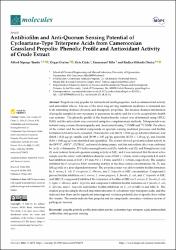Antibiofilm and Anti-Quorum Sensing Potential of Cycloartane-Type Triterpene Acids from Cameroonian Grassland Propolis: Phenolic Profile and Antioxidant Activity of Crude Extract
Künye
Tamfu, A.N.; Ceylan, O.; Cârâc, G.; Talla, E.; Dinica, R.M. Antibiofilm and Anti-Quorum Sensing Potential of Cycloartane-Type Triterpene Acids from Cameroonian Grassland Propolis: Phenolic Profile and Antioxidant Activity of Crude Extract. Molecules 2022, 27, 4872.https://doi.org/10.3390/molecules27154872Özet
Propolis is very popular for its beneficial health properties, such as antimicrobial activity and antioxidant effects. It is one of the most long-serving traditional medicines to mankind due to its interesting chemical diversity and therapeutic properties. The detailed chemical information of propolis samples is very necessary to guarantee its safety and for it to be accepted into health care systems. The phenolic profile of the hydroethanolic extract was determined using HPLC-DAD, and the antioxidant was evaluated using five complementary methods. Triterpenoids were isolated using column chromatography and characterized using 1H NMR and 13C NMR. The effects of the extract and the isolated compounds on quorum sensing mediated processes and biofilm formation in bacteria were evaluated. Protocatechic acid (40.76 ± 0.82 µg/g), 4-hydroxybenzoic acid (24.04 ± 0.21 µg/g), vanillic acid (29.90 ± 1.05 µg/g), quercetin (43.53 ± 1.10 µg/g), and luteolin (4.44 ± 0.48 µg/g) were identified and quantified. The extract showed good antioxidant activity in the DPPH•, ABTS•+, CUPRAC, and metal chelating assays, and this antioxidant effect was confirmed by cyclic voltammetry. 27-Hydroxymangiferonic acid (1), Ambolic acid (2), and Mangiferonic acid (3) were isolated from anti-quorum sensing activity at MIC, and it was indicated that the most active sample was the extract with inhibition diameter zone of 18.0 ± 1.0 mm, while compounds 1, 2, and 3 had inhibition zones of 12.0 ± 0.5 mm, 9.0 ± 1.0 mm, and 12.3 ± 1.0 mm, respectively. The samples inhibited the P. aeruginosa PA01 swarming motility at the three tested concentrations (50, 75, and 100 μg/mL) in a dose-dependent manner. The propolis extract was able to inhibit biofilm formation by S. aureus, E. coli, P. aeruginosa, C. albicans, and C. tropicalis at MIC concentration. Compound 1 proved biofilm inhibition on S. aureus, L. monocytogenes, E. faecalis, E. coli, and C. tropicalis at MIC and MIC/2; compound 2 inhibited the formation of biofilm at MIC on S. aureus, E. faecalis, E. coli, S. typhi, C. albicans, and C. tropicalis; and compound 3 inhibited biofilm formation on E. faecalis, E. coli, C. albicans, and C. tropicalis and further biofilm inhibition on E. coli at MIC/4 and MIC/8. The studied propolis sample showed important amounts of cycloartane-type triterpene acids, and this indicates that there can be significant intra-regional variation probably due to specific flora within the vicinity. The results indicate that propolis and its compounds can reduce virulence factors of pathogenic bacteria.


















